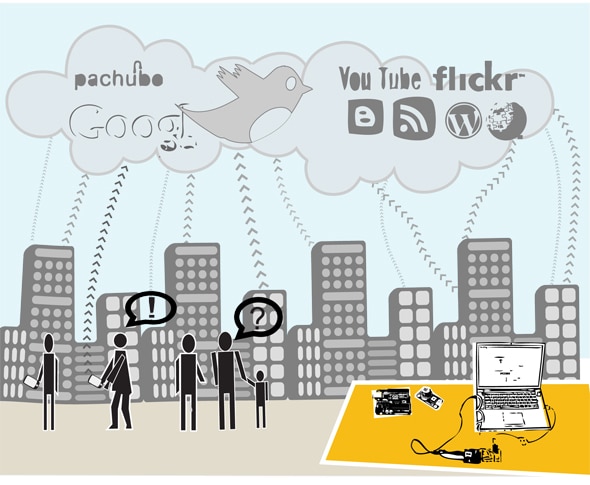
This post is the second of 4 posts about Participatory Sensing (projects and research) that we are publishing weekly on Fridays.
In this post I’m introducing relationships among citizens, sensors and data as preliminary stages towards participatory sensing projects in the context of smartcities.
Citizenship and data.
In the industrialized countries every city has official sensor monitoring, promoted by governmental bodies. Governments use expensive and high-technologies in cities in order to estimate the values of citizen’s exposure to many different phenomena. All data collected is supposed to make new phenomena visible and observable to improve governmental decision-making that can fit better into the reality of the city. A very concerned citizen could come upon this data and would probably find a great big pdf document with a non legible amount of data. This is the context in which the open-data movement and especially the open-data government is being developed. Nowadays we can find some very interesting initiatives: next a six minute video of Tim Berners-Lee at TED (conference) 2010 showing examples of open data.
Citizen sensor networks.
Amit Sheth in his Citizen Sensing, Social Signals, and Enriching Human Experience paper (2009) refers to the term citizen-sensor network as “an interconnected network of people who actively observe, report, collect, analyze and disseminate information via text, audio, or video messages”. It announces the advantages of introducing citizen-sensors in the normal data collection process, that was previously run by stand-alone sensor networks. A citizen sensor will use technologies like mobile devices and web 2.0 services to share their observations in real-time. As an example of citizen sensing, Amit describes how the microblogging information flow on the 2008 Mumbai attacks provided « enhanced situational awareness« , that a machine-based sensing system could not offer alone. Humans can contextualize and decide what is interesting and filter data collectively. Citizen-sensors will also adapt what they observe in real time and generate contextual knowledge from data collection.
Data is Political.
 Took of from Australia. Landed in China.
Took of from Australia. Landed in China.
I received this link in my inbox a week ago. This picture was uploaded at es.reddit.com. What if citizens shared more than observations and started sharing trustworthy data about the air quality or noise pollution? What would happen if citizens started sharing data related to public health issues?
Data can influence public policies because “data is political”. All data collected on environmental phenomena has consequences on our health and on our every day life. If we had data about noise pollution in a neighborhood we would take this into account when deciding where to buy a house. An example of this kind of visualization project is In The Air: “which aims to bring to light the microscopic agents of Madrid´s air (gases, particles, pollen, diseases, etc) and make them visible, to see how they perform, react and interact with the rest of the city.”
Participatory sensing.
Participatory Sensing is described in wikipedia as “the concept of communities (or other groups of people) contributing sensory information to form a body of knowledge”. In 2006 a team in UCLA wrote this research paper on Participatory Sensing to introduce the term “mobile devices, such as cellular phones, to form interactive, participatory sensor networks that enable public and professional users to gather, analyze and share local knowledge”. They developed a software called Partisan designed “to support a new model that places users in the loop of the sensing process and aims to maximize the credibility of the data they collect”. Protecting privacy and encouraging participation are important issues that were raised by the research team.
Participatory sensing research is mostly taking place in universities but also in other contexts.
Often such other participatory sensing initiatives are framed as promoters of the public interest. Professional researchers, amateurs and air quality enthusiasts meet in places like Medialabs or Hackerspaces and start-up a projects on participatory sensing. In the next post I will mention some participatory sensing bottom-up data collection projects that place citizens not only as sensors but also as actors.
Bibliography:
Burke, J. A., Estrin, D., Hansen, M., Parker, A., Ramanathan, N., Reddy, S., & Srivastava, M. B. (2006). Participatory sensing. Retrieved from https://escholarship.org/uc/item/19h777qd.pdf
Sheth, A. (2009). Citizen Sensing, Social Signals, and Enriching Human Experience. IEEE Internet Computing, 13(4), 87-92. doi:10.1109/MIC.2009.77
Goodchild, M. F. (2006). CITIZENS AS SENSORS: THE WORLD OF VOLUNTEERED GEOGRAPHY 1 Michael F. Goodchild, 1-15. Retrieved from https://www.ncgia.ucsb.edu/projects/vgi/docs/position/Goodchild_VGI2007.pdf
This post is by Sara Alvarellos, a guest editor at complexitys.com
Sara Alvarellos is a young architect interested in citizen engagement and implications of technology for architecture and urbanism, actually collaborating with sienteTecity and Oblomobka. Currently researching about Contemporary production, commons and The Internet of Things into Masterdiwo_Alicante framework.
PARTICIPATORY SENSING 2/4 – Cities, citizens and Participatory Sensing
5,2K

4 comments
This is an interesting series. With Rio+20 coming up, hopefully Principle 10 of the declaration gets special attention. It talks about participation and the recent Eye On Earth Summit will provide some input with regards to the involvement of citizens in M+E matters for environmental purposes. In my eyes, urban is one type of ecosystem and this approach could be applied to other ecosystems. I also like to make the distinction between hard sensing which is traditionally IoT and soft sensing which is more in line with Open311 and crowd mapping services. It seems to me there’s room for both. Finally, in light of all the Smart*Cities hype, this type of bottom-up involvement of citizens opens the door for a Common Sense City which leaves the individual and cultural heritage in the center.
Looking forward to the following posts!
JP
[…] the previous post I presented an overview about the relationship between citizens and data. Data means nothing […]
[…] […]
[…] the previous post I presented an overview about the relationship between citizens and data. Data means nothing […]